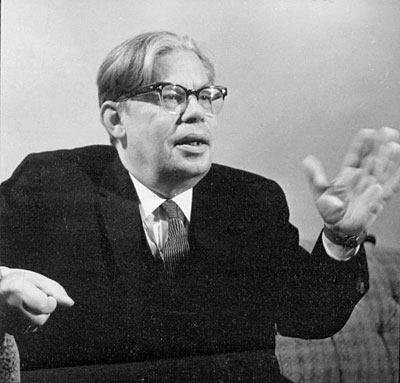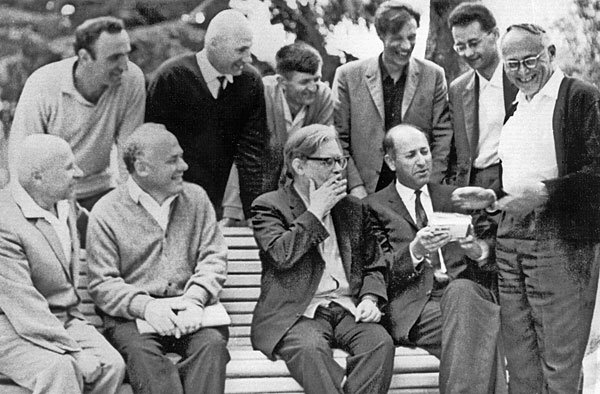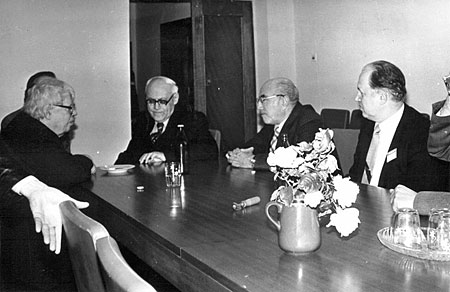| National Science Center KIPT | EN RU |
Dates of Life and Activity
Scientific Biography
Awards and Prizes
Scientific Activity
Scientific Achievements
Main Publications
Recollections
About A.I. Akhiezer
Photoalbum
Video
Reminiscences about Nikolai Nikolaevich Bogolyubov
A. I. Akhiezer

Nikolai Nikolaevich Bogolyubov
Before embarking on the task of writing these reminiscences about Nikolai Nikolaevich Bogolyubov, I asked myself why I was doing this at all. After all, many associates of his were closer to him than I was, and hence they could have written better and in greater details about him. All I can state in my defense is that I was a very close friend of Nikolai Nikolaevich for many years, held him in great esteem and revered him. He, too, was very kind to me. Hence I feel that I have a right to put on paper my remembrances, and hope to reminisce well. But this is not the only reason.
The years of creative activity of Nikolai Nikolaevich coincide with those of Lev Davidovich Landau, my close friend and mentor. It must be admitted that their mutual relations were not always cordial. Theirs were two strong personalities but of different bent. They possessed enormous creative abilities, but Landau was only an armchair scientist while Bogolyubov was also a prominent social worker who occupied a number of vital posts and was a very influential person in the highest government circles.
The history has judged each of them and put everything in its proper place. So we can now clearly assess the contribution to theoretical physics made by each of these scientists. These contributions do not in any way confront but rather complement each other in the golden treasure of theoretical physics.
What contribution was made by Nikolai Nikolaevich as a theoretical physicist?
Above all, he showed how various types of kinetic equations can be derived from general laws of mechanics. As a matter of fact, this problem dates back to Boltzmann's time since he published his famous kinetic equation. However, it was believed that this equation does not need a derivation. Such a conclusion was made, for example, by Landau and Lifshitz in the first edition of their "Continuous Media" book. Bogolyubov realized that there exists a fundamental problem of derivation of kinetic equations and showed how it can be solved.
However, Bogolyubov's contribution to statistical physics certainly does not end here. He is the author of a brilliant theory of a weak nonideal Bose gas which can essentially be treated as the microscopic theory of superfluidity (the macroscopic theory of superfluidity was built by Landau. Bogolyubov introduced Green's time-dependent functions in statistical physics and also proposed a new method for describing superconductivity.
Bogolyubov's contribution to quantum field theory is equally significant. He was the first to show how the dispersion relations can be proved in the theory of elementary particles, and gave a rigorous mathematical substantiation for renormalizations in all orders of the perturbation theory. He also played a role in the development of the renormalized group theory. Finally, he was among the first who realized that color of quarks should be introduced as a new quantum number in order to "rescue" Pauli's exclusion principle.

The participants of International Conference on Quantum Field Theory, Yalta, Sanatorium «Parus», 1966. First from the left in the first row - A.S. Davydov, at centre - N.N. Bogolyubov and Robert Marshak (USA). Standing (from right to left): A.I.Akhiezer, V.P.Shelest, M.K.Polivanov, O.S.Parasyuk, Yu.A.Mitropolsky, A.N.Tavkhelidze
The personality of Nikolai Nikolaevich is reflected in his response to the events associated with the name of A. D. Sakharov and with the activities of his pupil A. A. Logunov.
Bogolyubov refused to sign the letter denouncing Sakharov, which was signed by many academicians and published in Pravda. In this connection. Bogolyubov told me how M. V. Keldysh. President of the USSR Academy of Sciences, came to obtain Academician I. M. Vinogradov's signature on this letter. Keldysh implored Vinogradov to sign the letter because Sakharov had published an article which could not be disregarded. Vinogradov wanted to read the article, but Keldysh seems to have said, "There is no need to read it, all Western newspapers have reported it." At this stage, Nikolai Nikolaevich laughingly said, "And what do you think Ivan Matveevich replied? ... He said, 'Mstislav Vsevolodovich, have you forgotten? Even Lenin said that not a single bourgeois newspaper is to be believed.' And Keldysh had lo leave empty-handed, without Vinogradov's signatures."
A. A. Logunov developed his gravitational theory in defiance of Einstein, and published a large number of papers. However, he failed to earn Bogolyubov's approval in this matter.
For me, Bogolyubov's name is associated for ever with Kiev, the city that is my first love (by the way, Nikolai Nikolaevich once confided to me that he loved two cities- Kiev and Paris). Kiev was the first large city to which I came from our small Cherikov in Belorussia. I entered Polytechnical Institute in Kiev. My brother Naum Il'ich, who later became a famous mathematician, told me that Kolya Bogolyubov, a young man who lived in Kiev, possessed an amazing mathematical talent. That he was staying with Academician N. M. Krylov, and that his father in his days had been a professor of theology in St. Vladimir University, Kiev.
I busied myself with my curriculum courses while my brother took charge of my physics and mathematics education. There was no scope for acquaintance with Bogolyubov, because nonlinear oscillations are not encountered in elementary courses of radio engineering. Even in Berg's book "Valve Generators", only linearized characteristics of valves are considered. True, I had read by this time Barkhausen's book on electronic valves and encountered the concept of "average steepness" of valves characteristics determining the steady-state regime of valve generators. However, it was a far cry from real nonlinear oscillations. It was only after a preliminary handling of the Van der Pol equation that I realized the enormity of the problem of nonlinear oscillations. Around this time, my brother gave me a book on nonlinear mechanics by N. M. Krylov and N. N. Bogolyubov. I could not go through this book at that time, and kept it aside for a more suitable occasion. Such an occasion arose much later, after the World War, when I delivered, as a Professor at the Military Radar Academy, a course on the physical principles of radio engineering. Here I actually got carried away and, using the remarkable book "Asymptotic Methods in the Theory of Nonlinear Oscillations" by N. N. Bogolyubov and Yu. A. Mitropol'skii, described in detail the theory of generators as well as receivers. I was highly satisfied by my lectures and I think that my officer-students also enjoyed these lectures because they contained truly sublime stuff.
I got acquainted with Nikolai Nikolaevich after the War. I believe this happened at the defense of one of his Ph.D. students at the Kiev University where Bogolyubov taught. I was invited in the capacity of an examiner and was introduced to Bogolyubov by the mathematician Semen Izrai-levich Zukhovitskii, later a Professor at the Kiev University, with whom we were old friends from our Cherikov days. He was on very cordial terms with Nikolai Nikolaevich. When all three of us were sitting together, I found the conversation so easy that I felt as if I had also known Bogolyubov since childhood. He also quickly grasped my line of thought.
Zukhovitskii subsequently emigrated to Israel and Nikolai Nikolaevich once enquired if I had any news about Semen Izrailevich. I told him about the letter which Zhukhovilskii had sent to a friend of my wife, informing that he was teaching at the Jerusalem University where he had to deliver lectures in the "holy" tongue. This is how he described the Hebrew language. After a brief pause, Bogolyubov said. "You know, Aleksandr Il'ich, it is truly a holy language!"
Afterwards, I met Nikolai Nikolaevich al each session of the Ukrainian Academy of Sciences and we always had long chats on various subjects, including scientific, historical, and even religious topics. He always impressed me with his encyclopedic knowledge, with precise reasoning, and logical remarks. Departing from him, I felt as if I had been charged with some spiritual energy. I even somehow felt better within my heart. I recall that my close friend Isaak Yakovlevich Pomeranchuk also shared the same experience. Whenever we met, we always marvelled al Bogolyubov's wisdom and talent.
I cannot help recalling an incident concerning Bogolyubov's work on a nonideal Bose gas. It was a delicate paper, in which the operators served both as operators and as C-numbers. The editorial board of JETP declined the paper, and Nikolai Nikolaevich decided to speak to Landau himself. At the meeting, Landau al once grasped the importance lo Bogolyubov's work and realized that it was not simply correct, but also brilliant. The paper, of course, was accepted for publication.
I met Bogolyubov frequently not only in Kiev, but also in Moscow where we usually stayed at the same hotel. I always visited him in his room and was, I believe, a welcome guest. We talked about various aspects of science and life.
When Nikolai Nikolaevich moved to Dubna, I frequently visited him. On one occasion, I also brought with me my son Il'ya who was planning to defend his doctoral thesis. Nikolai Nikolaevich listened to him attentively and wrote a good evaluation report.
When I was offered the post of Deputy Director of UPTI in charge of nuclear physics, I turned to Pomeranchuk and Bogolyubov for advice. Both of them suggested that I should accept the offer. I did accept the job, taking the cue from Nikolai Nikolaevich who had become the Director of the Joint Institute of Nuclear Research. He promised to help, and I even spoke at the meeting of the Council of JINR with my proposals on what needed to be done for the development of high energy physics at the UPTI.
Even after his transfer to Dubna, Bogolyubov paid considerable attention towards the development of theoretical physics in the Ukraine. He always took care that vacancies were released by the Presidium of the Ukrainian Academy of Sciences for the most talented and deserving scientists, and later offered them full support for securing the appointments. Among others, the theoretical physicists of our institute (UPTI), who are presently Members of the Ukrainian Academy of Sciences, also owe their positions to this policy of Bogolyubov.

International conference on the nonlinear phenomena at the Institute for Theoretical Physics, Kiev, 1984. From left to right: N.N.Bogolyubov, A.I.Akhiezer, Ya.B.Zeldovich, V.G.Baryakhtar (courtesy of V.G.Baryakhtar)
At Bogolyubov's initiative, the Institute of Theoretical Physics was founded in Kiev in 1966. Nikolai Nikolaevich was appointed the Director of the Institute and V. P. Shelest was appointed the Deputy Director. At one time, Nikolai Nikolaevich wanted me and my closest associates to move to Kiev, but this plan did not materialize for some reasons. So we continued our close cooperation from two different cities. I frequently visited Kiev and once spent an entire summer in Feofaniya, where the Institute is located.
Bogolyubov and Shelest managed to organize an International School on theoretical physics in the Crimea, the Rochester Conference on high-energy physics, as well as International Conferences on plasma physics and nonlinear effects in Kiev. All these conferences attracted a large number of participants from abroad and were enormously successful.
I am glad to note that the Institute of Theoretical Physics, which is a brainchild of Nikolai Nikolaevich, is headed at present by Aleksei Grigor'evich Sitenko, Member of the Ukrainian Academy of Sciences, an outstanding scientist and a pupil and close associate of myself. The Institute has been named after N. N. Bogolyubov.
The scientific heritage of Bogolyubov is enormous. It concerns various fields of theoretical physics, and I can take pride in the fact that the development of theoretical physics research is being carried out successfully at the Kharkov Physicotechnical Institute by Academician Sergei Vladimirovich Peletminskii, a remarkable scienlia wfe: my oldest pupil and close associate.
N. N. Bogolyubov always tried to support good initiatives. When the L. D. Landau Institute of Theoretical Physics was founded in Moscow, it was Bogolyubov who supported Academician Isaak Markovich Khalatnikov, the initiator of the project.
There are two institutes of theoretical physics at present, the L. D. Landau Institute in Moscow and the N. N. Bogolyubov Institute in Kiev. This is quite symbolic and underlines the profound role of these two leaders in the development of theoretical physics and the founding of their scientific schools.
Translated by R. S. Wadhwa
© 1994 American Institute of Physics
This article first appeared in Low Temp. Phys. 20 (8), August 1994 [Fiz. Nizk. Temp. 20, 845-847 (August 1994)]
| © NSC Kharkov Institute of Physics and Technology | Designed by Alex Davydov |